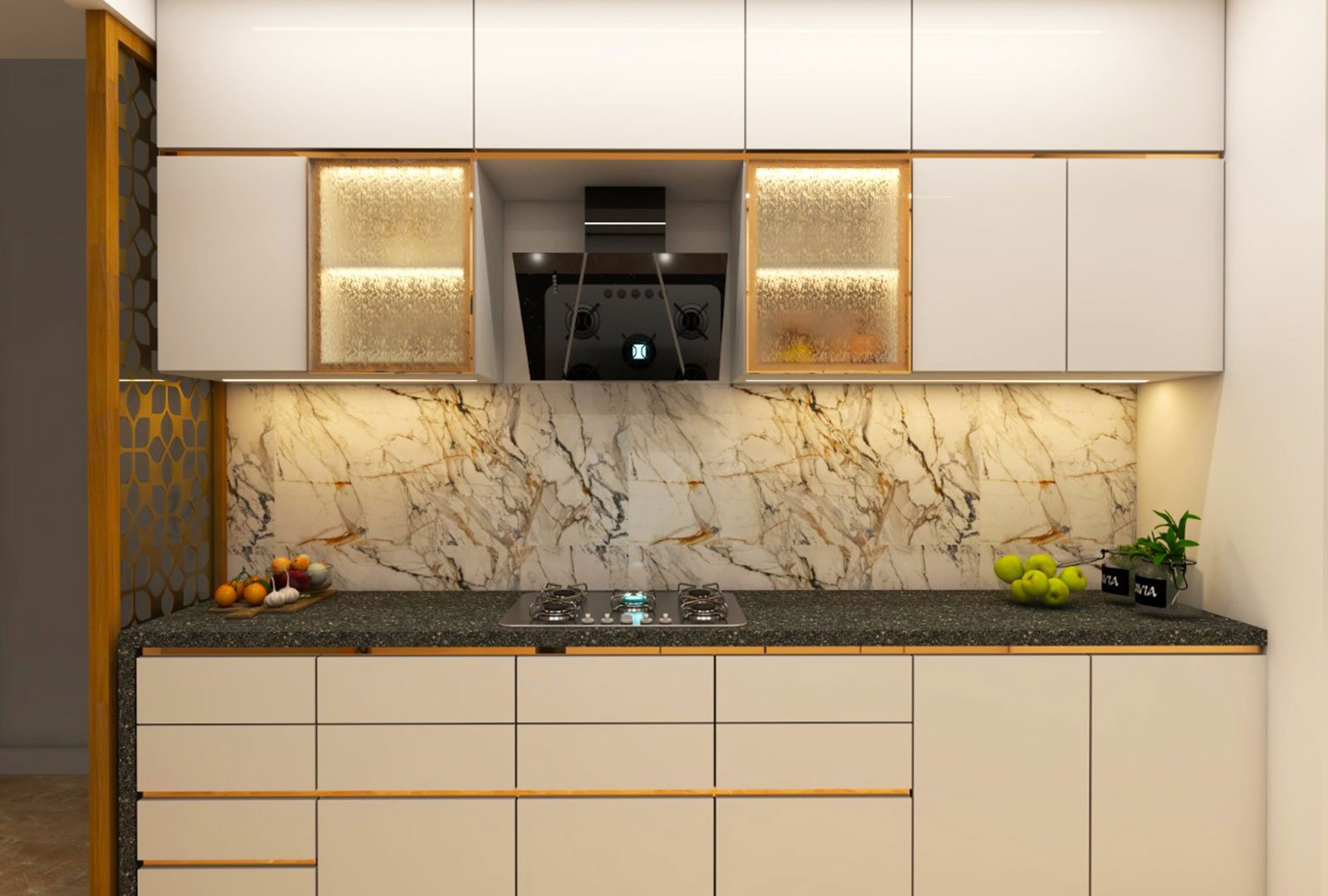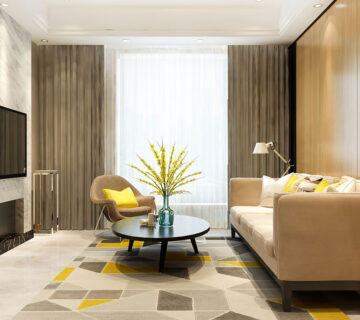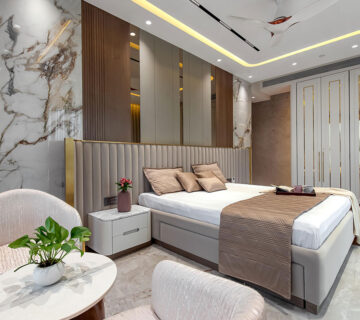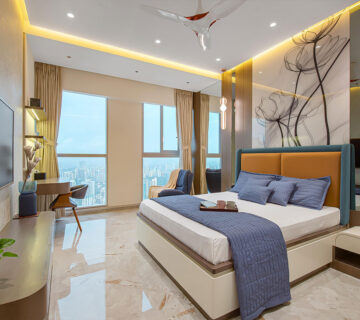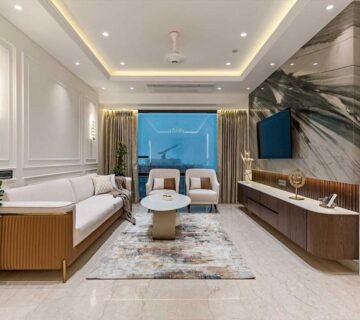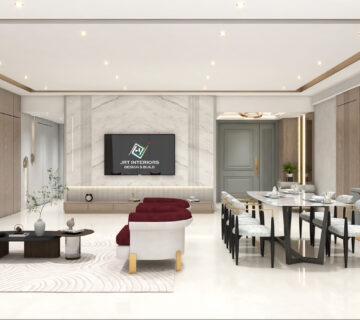The kitchen is the heart of your home. It’s where you cook, eat, and gather. Because it’s a high-traffic, high-moisture area, choosing the right materials for your kitchen interior is a critical decision. It’s a balance of style, durability, and budget. This comprehensive guide will walk you through selecting the best materials for your countertops, cabinetry, flooring, and backsplash. Making informed choices ensures your kitchen interiors is beautiful, functional, and built to last.
1. Kitchen Countertops: The Functional Focal Point
Your countertop handles the most daily wear and tear. It must withstand heat, spills, and impact. Durability and maintenance are key factors in your selection.
Quartz (Engineered Stone)
Quartz is the most popular choice today. It is an engineered stone made from natural quartz crystals and resin.
- Pros: It’s non-porous, making it highly stain-resistant and hygienic. It never requires sealing. It comes in a vast range of colors and patterns.
- Cons: It can be expensive. Prolonged, intense heat (like a hot pot) can damage the resin.
- Best For: Busy households seeking a low-maintenance, consistent look.
Granite (Natural Stone)
Granite is a classic, naturally occurring stone. Each slab is unique.
- Pros: Extremely durable and highly resistant to heat. It adds significant resale value to a home.
- Cons: It is porous, so it requires periodic sealing (usually once a year) to prevent stains. It is also one of the heavier materials.
- Best For: Homeowners who prioritize natural beauty and a high-end, heat-resistant surface.
Marble (Natural Stone)
Marble is known for its luxurious look and elegant veining.
- Pros: Incomparable classic beauty. It is naturally cool, which is ideal for baking and pastry work.
- Cons: It is softer and highly porous. It is prone to etching (damage from acids like lemon juice) and staining. High maintenance is a must.
- Best For: Designers and homeowners who value aesthetics and are committed to diligent maintenance.
Butcher Block (Wood)
Butcher block adds incredible warmth and a rustic charm to any kitchen.
- Pros: It’s affordable, can be easily repaired by sanding, and is a sustainable option.
- Cons: It’s high maintenance. It requires regular oiling to protect against moisture and must be sealed for food safety. It is not heat or scratch-resistant.
- Best For: Islands or specific prep areas where a warm, natural look is desired.
2. Kitchen Cabinetry: Defining the Style
Cabinets take up the most visual space in a kitchen. The material you choose dictates the longevity and finish of your kitchen’s dominant feature.
Solid Wood
Solid wood (like maple, cherry, or oak) is the gold standard for cabinetry.
- Pros: Extremely durable and can be refinished multiple times. It adds timeless value.
- Cons: It is the most expensive option. Wood can expand and contract with humidity, which may lead to cracking paint or warping doors over time.
- Best For: A classic look, longevity, and a high-budget project.
Plywood
Plywood is constructed from layers of wood veneer glued together. It’s often used for the cabinet box structure.
- Pros: Excellent strength and stability. It is less likely to warp or crack than solid wood. It’s more cost-effective.
- Cons: Edges must be covered. Lower grades may contain voids.
- Best For: A durable cabinet box material that balances quality and cost.
MDF (Medium-Density Fiberboard)
MDF is made from wood fibers, wax, and resin pressed into panels.
- Pros: Very affordable and provides a perfectly smooth surface for painted finishes. It resists warping and cracking better than solid wood.
- Cons: It’s heavy and can be damaged permanently by water if the finish is compromised. It can’t be stained.
- Best For: Painted cabinets and budget-conscious renovations.
Thermofoil
Thermofoil is a vinyl film applied to an MDF core using heat and pressure.
- Pros: Very affordable, easy to clean, and resists moisture. The finish is consistent.
- Cons: Can be damaged or peel away if exposed to excessive, prolonged heat (like above a self-cleaning oven). Cannot be refinished.
- Best For: Low-maintenance, uniform finishes and rental properties.
3. Kitchen Flooring: A Durable Foundation
Kitchen floors need to handle dropped items, heavy foot traffic, and inevitable spills. Waterproof and durable materials are paramount.
Porcelain or Ceramic Tile
Porcelain and ceramic are the most popular choices for kitchen flooring.
- Pros: Waterproof, extremely durable, and easy to clean. They offer endless design versatility, including wood-look and stone-look options. Porcelain is harder and less porous than ceramic.
- Cons: Grout lines require regular cleaning. The surface is hard and cold. Dropped items will often break.
- Best For: Ultimate water resistance and longevity in busy kitchens.
Luxury Vinyl Flooring (LVT/LVP)
Luxury Vinyl has made enormous strides in quality and realism.
- Pros: Highly waterproof, comfortable underfoot, and very scratch-resistant. It’s often DIY-friendly to install. It mimics wood and stone convincingly.
- Cons: Not all varieties are heat-resistant. It can sometimes be pierced or dented by sharp objects.
- Best For: Budget-friendly, waterproof durability with the look of natural materials.
Engineered Hardwood
Engineered hardwood offers the look of real wood with increased stability.
- Pros: Provides the classic, warm look of natural wood. The cross-ply construction makes it more stable than solid hardwood.
- Cons: It’s still susceptible to water damage if spills are left for too long. More expensive than vinyl or laminate.
- Best For: Creating a seamless flow with existing hardwood floors in other rooms.
4. Kitchen Backsplashes: Protection and Style
A backsplash protects your wall from cooking splashes. It’s also a key decorative element.
Ceramic and Porcelain Tile
Ceramic and porcelain are affordable and versatile.
- Pros: Extremely durable, easy to clean, and affordable. They allow for huge customization in size, shape (e.g., subway, herringbone), and color.
- Cons: Grout lines can collect dirt and grease.
- Best For: Classic style, intricate designs, and budget flexibility.
Natural Stone Slabs
Using the same slab as your countertop (granite, quartz, marble) for the backsplash.
- Pros: Creates a seamless, high-end, and elegant look (often called a “countersplash”). Eliminates grout lines entirely.
- Cons: Very expensive due to the cost of the material and fabrication.
- Best For: Achieving a luxury, minimalist, and monolithic design.
Glass
Glass tiles or panels are sleek and reflective.
- Pros: Non-porous, very easy to wipe clean, and its reflectivity helps to make small kitchens appear brighter and larger.
- Cons: Glass can be more prone to showing smudges and fingerprints.
- Best For: Modern kitchens needing a pop of color or a bright, reflective surface.
5. The Decision Matrix: How to Choose
Making the final material choice is about aligning four key factors: budget, durability, style, and maintenance.
- Define Your Budget: Materials like laminate and MDF are budget-friendly. Quartz and solid wood are high-end investments. Be realistic about what you can afford.
- Assess Your Lifestyle: Do you cook daily, with kids or pets? You need high-durability, low-maintenance materials like quartz, porcelain tile, and plywood cabinets. If you cook rarely, you can select softer, higher-maintenance options like marble or solid wood.
- Establish Your Style: Do you want a modern, traditional, or industrial look?
- Modern: High-gloss acrylic cabinets, sleek quartz counters, glass backsplash.
- Traditional: Solid wood cabinets, granite counters, ceramic subway tile backsplash.
- Industrial: Stainless steel accents, concrete-look counters, metal tiles.
- Prioritize Maintenance: Are you willing to seal your granite counter or oil your butcher block? If not, opt for low-maintenance, non-porous materials like quartz and porcelain.
By systematically evaluating each element—from the high-impact countertop to the foundational floor—you ensure your kitchen is a beautiful, cohesive, and practical space for years to come. Choose wisely, and enjoy the heart of your home!
Frequently Asked Questions (FAQ)
Q1: Which countertop material adds the most value to a home?
A: Natural stone, particularly granite and high-quality quartz, generally adds the most perceived and real value. Buyers associate these materials with durability and luxury.
Q2: Is MDF a bad choice for kitchen cabinets?
A: No, MDF is an excellent choice for painted cabinets. It provides a smoother, more consistent finish than wood and resists cracking. However, it’s crucial to choose a high-quality finish to protect the core from moisture damage.
Q3: What is the most durable and low-maintenance kitchen floor?
A: Porcelain tile and Luxury Vinyl Plank (LVP) are the top choices. Porcelain is virtually indestructible and waterproof. LVP is softer but highly water-resistant and scratch-proof, making it ideal for high-traffic, wet areas.
Q4: Should my backsplash match my countertop?
A: It doesn’t have to match perfectly, but it should complement it. A popular and modern trend is to use the same slab material for both for a seamless look. Alternatively, choose a neutral, simple backsplash (like white subway tile) to let a busy countertop pattern be the focal point.
Q5: How much should I budget for high-quality materials?
A: For a complete kitchen renovation using high-quality, durable materials (quartz, solid-wood framed cabinets, porcelain tile), expect to budget between 20% to 35% of the total project cost just for the main materials, excluding labor, appliances, or plumbing fixtures. Always get multiple quotes.
🏡 Connect with JRT Interior in Thane today and let our experts design a kitchen interior that blends beauty, comfort, and functionality.

